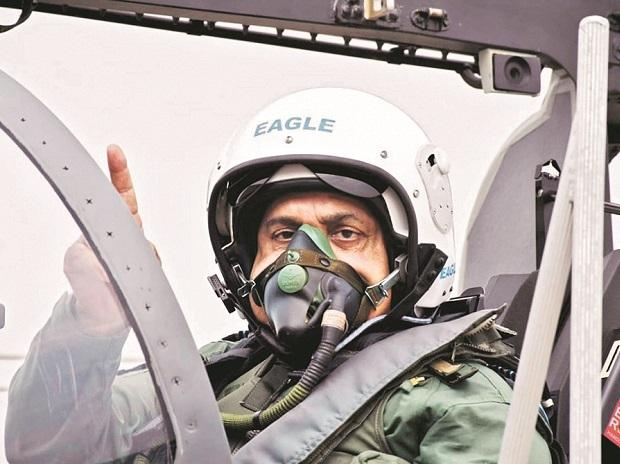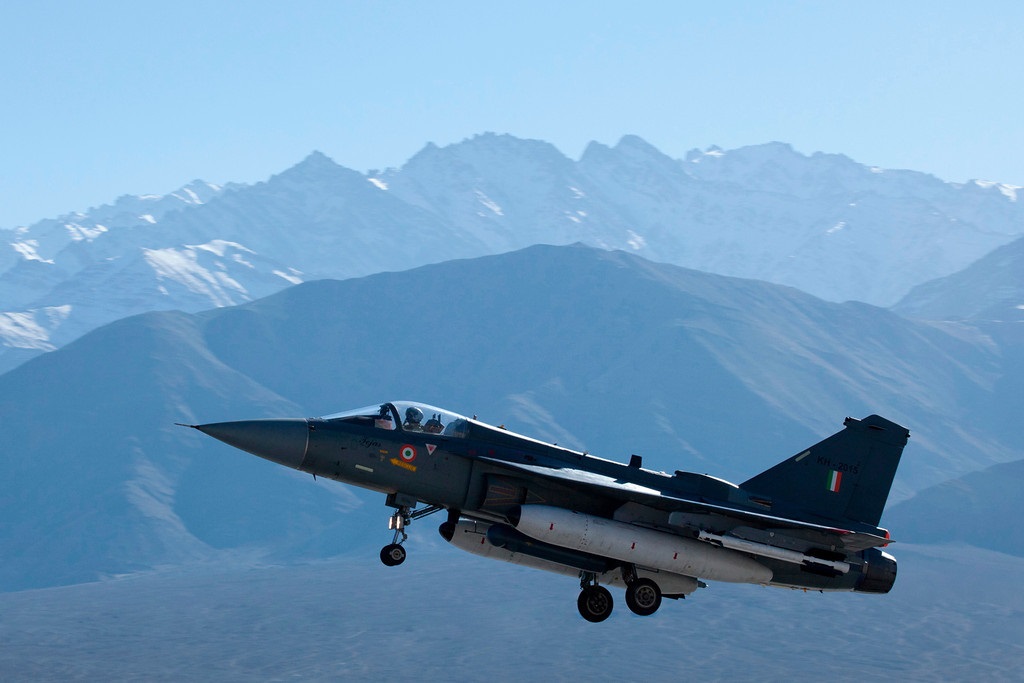
IAF gets second Tejas squadron; Air Chief shows the way with solo sortie
Air force chiefs, including Pakistan's recently, often go up for a spin to boost the morale of their fighter pilots.

Most of these later ones are in advance stages of delivery or development, by Jun next year they will easily get at least 8 of these. By the end close to 10 to 12 of these, if the reports are correct.IAF gets second Tejas squadron; Air Chief shows the way with solo sortie
IAF gets second Tejas squadron; Air Chief shows the way with solo sortie
Air force chiefs, including Pakistan's recently, often go up for a spin to boost the morale of their fighter pilots.www.business-standard.com
Yup he said it month ago that Surprise in December... Don't know but let's see if Deal gets signed or not this month...Whaaa?? AK on twitter said that will be signed in December.
| Uttam's QTRM configuration |
| Terrain Avoidance- The valley in front of the aircraft is black indicating that there is no terrain at the current altitude |
| Chirp pulse |
| Slotted PlanarArray of the hybrid variant of EL/M-2032 MMR fitted in LCA Tejas, slots for IFF receiver dipoles visible |
This sounds great, but since we know how the forces operate, they will not take it. Does anybody have an identification on the people that lobby against using indigenous technology?Various aspects of Uttam AESA radar:
Physical specifications of the slotted-planar array used LCA's hybrid-MMR-
- Uttam features an active phased array (APAR) which gives it superior scanning performance over legacy passive phased array radar. Unlike most contemporary radars, Uttam features Quad TRM i.e. a single plank consists of 4 TRMs. It allows the array to be more densely packed. Each TRM is equipped with low noise power amplifier, built-in test facility, digital phase-gain, and side lobe control elements. The inert model displayed at Aero India 2015 had ~184 QTRMs i.e. 736 TRMs. The array temperature is controlled by a liquid coolant circulation system. The QTRM configuration makes Uttam maintenance friendly. The radar can be scaled up or down depending on antenna size requirement.
View attachment 71397 Uttam's QTRM configuration
- The radar is capable of tracking 100 targets simultaneously and engage 6 of them by SARH/ARH missiles in high priority tracking mode. For comparison, Elta EL/M-2052 is capable of tracking 64 targets in TWS mode.
- In 2015 Uttam was stated to be capable of tracking a target having RCS of 2m2 at a distance of 92 kilometers. According to the new reports, the range has been increased to 150 kilometers for the target of the same RCS. In GMTT mode 2 targets can be tracked.
- Uttam has over 16 different types of operational modes and the radar can operate in multiple modes simultaneously by changing modes pulse-to-pulse which gives the pilot exceptional situational awareness and mission flexibility.
- Air-To-Air
- TWS (Track While Scan): Combination of search and track, essentially a surveillance mode.
- HPT – High priority Target: Dedicated tracking mode, also referred to as “Hard Lock”.
- AACQ/ACM (Auto-Acquisition/Air Combat maneuvering): radar searches a certain area and detected targets are automatically locked on transferred to HPT allowing the pilot to fire missiles quickly- Rapid target engagement.
- AJ (Anti-Jam): Rapid frequency changes and other techniques to cut through heavy jamming.
- RA (radar altimeter): measures altitude of the aircraft.
- Weather: Weather observation
- Air-To-Sea
- Sea TWS: Search and tracks targets on the water surface, high processing requirement to cut through the clutter. It also includes SSS (sea surface search)
- RS (Range Signature): Generating 1D profile of sea target, essentially a ‘quick look’, assessing the area of interest in a target, such as its length, position of high reflectivity area
- ISAR (Inverse Synthetic Aperture Radar): Imaging the target for classification, RS and ISAR are usually coupled with an automatic classification library
- STCT (Sea Target Continuous Track): Similar to air-to-air HPT but for sea targets
- Air-To-Ground
- AGR (Air-To-Ground Ranging): Radar uses a continuous single beam for ranging, similar to a laser rangefinder. Range information is used to assist gunfire (strafing run) and visual bombing.
- RBM (Real Beam Mapping): Radar scans the terrain to generate a topographic map. Pilots can use this map for terrain avoidance. It allows the aircraft to fly low while avoiding collision with a feature or ground.
View attachment 71398 Terrain Avoidance- The valley in front of the aircraft is black indicating that there is no terrain at the current altitude
- SAR/DBS/HRM (Doppler Beam Sharpening/ High-Resolution Mapping): Enhanced Imaging mode used for high-resolution imaging of ground. Since the actual aperture of radar is very small compared to wavelength and energy is spread in a wide area, DBS is used to enhance the resolution.
- GMTI/GMTT (Ground Moving Target Tracing/Indication): Detection of a moving target on the ground, other objects such as trees and buildings are filtered out. These modes can be interleaved with RBM/SAR to produce terrain map and track the target at same time.
- Navigation
- Weather
- Terrain Avoidance.
- Advanced Electronic Counter-Countermeasure capabilities of Uttam AESA radar:
- Wide bandwidth: Since each TRM can generate and transmit radiate its own signal of different phase and frequency, a large number of spectral components can be generated in a single pulse i.e. radar can spread its frequencies across a wide band in a single pulse.
View attachment 71399 Chirp pulse
The ability to quickly switch the frequency and wide bandwidth make Uttam a Low-Probability-of-intercept (LPI) radar i.e. it is difficult for an RWR to intercept it.- Frequency agility: The Radar can rapidly+randomly switch through a large number of frequencies spread across wide bandwidth to counter certain types of jamming.
- Sidelobe Cancellation (SLC): SLC is a technique used to removing interference in which the processor subtracts the interference from the antenna output. It is designed to operate against active jammers. It is assumed that the jamming signal is entering the radar antenna through one of the sidelobes. In SLC, auxiliary antennas are used to gather information about interfering signal, the resulting signal is sent to rest of radar receiver and processor via SLC channels and interference is neutralized. Having multiple SLC channels allows Uttam to neutralize multiple jammers simultaneously.View attachment 71400
- Ultra-low sidelobe antenna: Uttam has an ultra-low sidelobe antenna which allows it to generate very sharp pencil beams. In AESA radars low sidelobe regions can be created with TRMs using independent phase control at each element. Having low sidelobe level not only improves steering/tracking performance but also increase immunity against jammers. It also helps the aircraft to avoid detection by passive RF tracking systems (Emitter locator systems).
View attachment 71401 Slotted PlanarArray of the hybrid variant of EL/M-2032 MMR fitted in LCA Tejas, slots for IFF receiver dipoles visible
- X-band
- diameter 650 mm (0.65 m)
- Peak power 10 KW
- Weight 4.8 kg
123 LCA will come CCS given approval.This sounds great, but since we know how the forces operate, they will not take it. Does anybody have an identification on the people that lobby against using indigenous technology?
Dont think CCS has already cleared 83 mk1a. Though not sure, the last thing I heard was MOD/DAC clearing it in March..123 LCA will come CCS given approval.
Now Its On DSPSU And MOD. For Meeting schedules or pushing dead line
Nevertheless MMRCA has nothing do With LCA because its completely different category of aircraft.
Well DAC already Cleared that means all Negotiation is doneDont think CCS has already cleared 83 mk1a. Though not sure, the last thing I heard was MOD/DAC clearing it in March..

What does it mean?
Source?#Tejas crashed Sp21
Iam the unfortunate pilot speaking.Source?
For f**k dude, stop, STOPPPPPPP, we already have enough people taking shots at Tejas...don't give us heart-attack like that, please, you almost made me depressed.Iam the unfortunate pilot speaking.
Iam the unfortunate pilot speaking.
Iam the unfortunate pilot speaking.
| Thread starter | Similar threads | Forum | Replies | Date |
|---|---|---|---|---|
|
|
LCA Tejas: Photos & Footages (no text other than headings) | Military Multimedia | 87 | |
|
|
LCA TEJAS and what makes it stand out | Knowledge Repository | 8 | |
| W | Rise of LCA Tejas Multi Role Fighter Aircraft | Indian Air Force | 23 | |
| C | LRUs or parts of LCA Tejas Made and designed in India | Indian Air Force | 16 |
